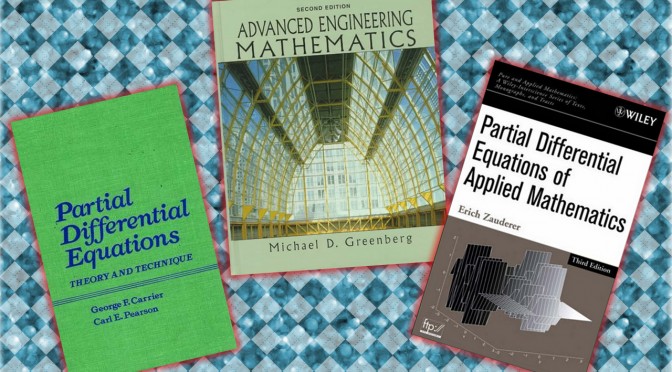Taking this course is an effort to brush up my maths. The lectures by Eli Tziperman are very well organized, and he always gave road maps at the beginning of lectures so that we always have the big pictures in mind (before getting lost in mathematical details).
The course covers mostly partial differential equations, from the standard 2nd order PDE like diffusion, wave, and Laplace equations, to 1st order PDE and method of characteristics, to Greens function method, to variational methods, perturbation methods, and some nonlinear PDE. It sounded silly, but when he finished Greens functions, I started to realize why mathematics is field of research.
One of the difficulties in learning maths on one’s own is that it is hard to choose which textbooks to use. Three main textbooks for this course are Carrier & Pearson’s Partial Differential Equations – Theory & Technique; Greenberg’s Advanced Engineering Mathematics, 2nd Ed; and Zauderer’s Partial Differential Equations of Applied Mathematics. I found Greenberg’s book delightful to read.
Greenberg’s book not only teaches maths, but also how to think about maths and physics. One of his most enlightening comments is quoted below:
On classification of PDEs: “Why do we classify so extensively? Because the most general differential equation is far too difficult for us to deal with. The most reasonable program, then, is to break the set of all possible differential equations into various categories and to try to develop theory and solution strategies that are tailored to the specific nature of a given category. Historically, however, the early work on differential equations – by such mathematicians as Leonhard Euler (1707-1783), Jakob (James) Bernoulli (1654-1705) and his brother Johann (John) ( 1667 – 1748), Joseph-Louis Lagrange (l736- 18l3), Alexis-Claude Clairaut ( 1713- 1765), and Jean le Rond d’Alembert ( 1717- 1783) – generally involved attempts at solving specific equations rather than the development of a general theory.”
In the language of my college maths teacher, one needs to see both the forest and the tree.
